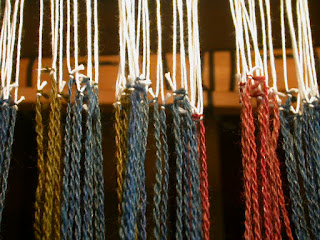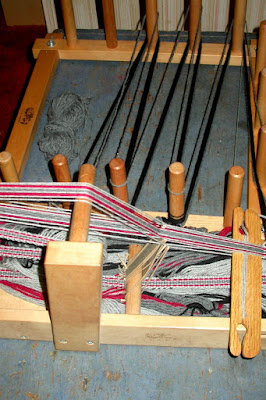A friend of mine was not able to take a private lesson last week, and I was able to fill in. The student was interested in getting back into weaving and improving her warping. So in our class, she warped my Baby Mac three times in three days. She also wound on a 6 yard hairy linen/cotton slub yarn on my Big Mac and I warped a towel warp on the Baby Wolf to use for weaving and tension correction helps.
I wove the first warp that night after she left for the day. It was a short warp for a runner. (She was not interested in getting a project out of the lessons, she just wanted to improve her process.) I wove a table mat to go in the kitchen.
 |
| Table mat woven but not washed. | | | | | | | | | | | | | | | | |
|
|
 |
| Third warp for a one strip bag. |
The second warp was narrow and long. I just took it off the loom after the lesson was over, there wasn't time to weave it. I will put it back on later to weave. The third warp was also narrow and long. I want to try to make the one strip bag from donisdelis.blogspot.com. She has a great little bag that she folds so that there is no cutting. I have been interested in that bag for a while but I did not have a strip of weaving to try it. These pieces may be a little stiff because I was using 3/2 pearl cotton for these warps. We will have to see what happens.
The warp on my Baby Wolf is a UFO, one of the "100 projects to finish"! I am thrilled to get it on a loom to weave. It is a fairly easy weave. The worse part is the single shot of boucle that I have to weave every 20 or 24 shots. You can see the shredded and tucked in ends on the left in the picture. I usually trim 3 or 4 at a time. After I weave the towels on this warp, I am going to tie on a green warp and do the companion towel.
This pattern is from an old Finnish weaving book that I have. The lace blocks were only about a half inch in the book, because the structure is for a summer dress fabric. I enlarged both the size of the blocks and the size of the yarn. The structure ends up being a 3 thread huck lace.
The last warp is on the Big Mac, and is another UFO and "100 projects". It is another towel. This towel is just plain weave with stripes of painted warp. I painted yarn for the stripes about 3 years (or more) ago...
 |
| Winding on the warp with a raddle. |
|
|
 |
| Weaving the towels. |
|
|
 |
| Repairing a knot in the warp. |
|
I noticed a knot in the painted warp, and I always paint a couple of extra warps for repairs. I pinned in the extra warp about an inch and a half before the knot and wove until it was about an inch and a half past the knot. I put a small safety pin in the selvedge to mark the knot so that I can cut it out when the towels are off the loom. This way, you will hardly be able to see the repair and I will not have a knot in the weaving.
Tonight when I walked upstairs and looked out the window I saw a beautiful sunset.
Nice way to end the day.




















































